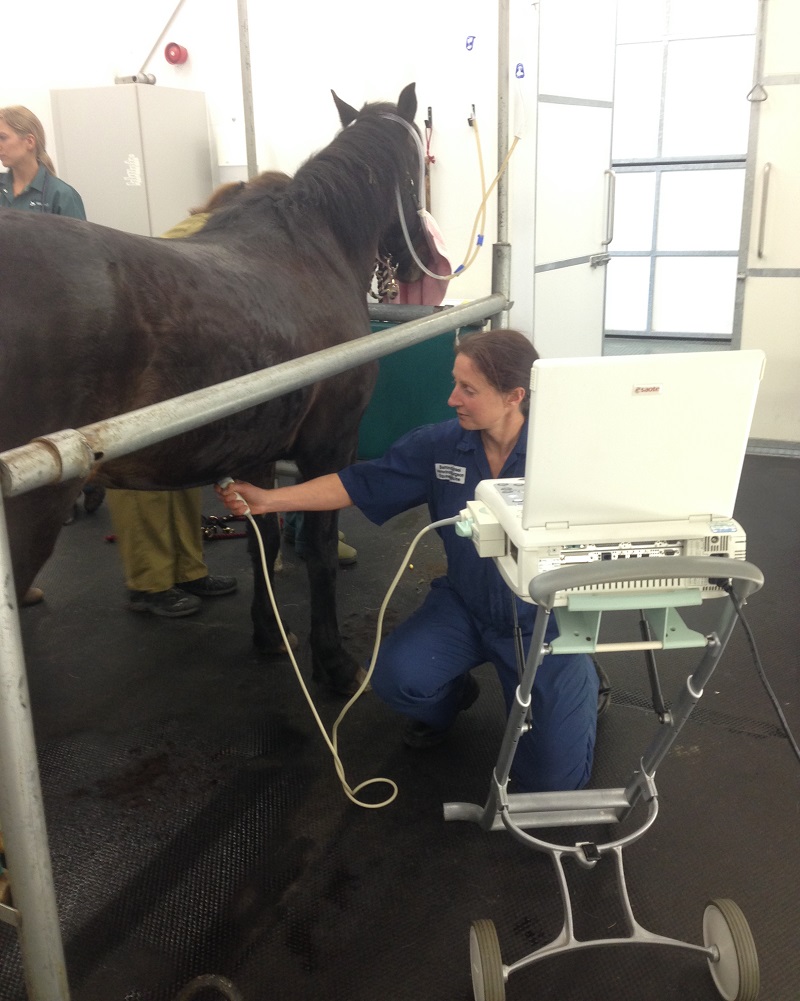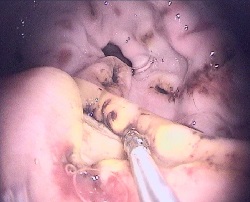Update on Gastrointestinal Diseases in Horses
Clinical Connections – Autumn 2021
Bettina Dunkel, Associate Professor in Equine Medicine
The most commonly described intestinal disease in horses is probably gastric ulcers and colic but other diseases such as colitis and inflammatory bowel disease also play an important role. The article describes selected recent developments in aetiology, diagnosis and treatment of equine gastrointestinal diseases.
Gastric ulcers remain a very common condition in horses and knowledge about different types of ulcers and different treatment options is rapidly expanding. It is now firmly established that squamous ulcers are quite different from glandular gastric ulcers in regard to predisposing factors, clinical signs and response to treatment – but a lot remains still to be discovered.
Recent research conducted at the RVC by Dr Mike Hewetson and presented at the 2021 conference of the British Equine Veterinary Association found no correlation between clinical signs perceived by owners and the presence or absence of glandular lesions. This highlights the importance of gastroscopy in confirming a diagnosis of gastric ulcers and evaluating response to treatment by repeated gastroscopy as clinical signs and owners’ perception are unreliable.

The mainstay of successful treatment for colic remains rapid recognition, immediate assessment and, in cases with a high likelihood of a strangulating lesion, timely exploratory surgery. For horses undergoing exploratory laparotomy, post-operative reflux remains a serious and potentially life-threatening complication. During the last two decades, a continuous intravenous infusion of lidocaine has become a routine treatment for horses recovering from small and occasionally also large intestinal surgery[1]. Potential benefits include prokinetic, anti-inflammatory and analgesic properties which are all indicated in post- operative patients. However, the clinical efficacy of lidocaine as prokinetic has been questioned and recent research suggests that it has minimal, if any, impact on post- operative reflux volume and duration[1, 2].
An international multi-centred double blinded study is currently underway to further investigate the proposed clinical properties of lidocaine and RVC Equine is one of the participating hospitals. If owners agree to enrolment, horses with a small intestinal obstruction included in the trial will receive either lidocaine or placebo (fluids) at no additional cost to the client, and postoperative pain and development of reflux are recorded. This important investigation will contribute to answering the important clinical question on best use of lidocaine in post-operative colic care.
Inflammatory bowel disease (IBD) is increasingly recognised as a cause of weight loss and hypoproteinaemia. Less well recognised presentations might include poor weight gain and recurrent colic. IBD is an umbrella term for a variety of often poorly defined inflammatory conditions that affect the small and large intestine of horses and may result in malabsorption. Diagnosis has long relied on abdominal ultrasonography, oral glucose absorption tests and duodenal/rectal biopsies. At RVC Equine, we have recently introduced a new test for malabsorption. Instead of using a glucose absorption test a combination of xylose and iohexol is used to assess not only absorption but also intestinal permeability. The test is more specific and has the potential for assessing both the small and large intestine, which significantly increases our ability to diagnose the condition and initiate appropriate treatment.
Colitis or typhlocolitis with or without diarrhoea is less common than colic but also a potentially life-threatening disease. Well documented causes of colitis include bacterial infections such as Salmonella and clostridial species and treatment with antimicrobials. RVC Equine is currently evaluating a new, rapid PCR test for Salmonella that can be performed on site which would significantly shorten the time it takes to make a diagnosis.
More recently, equine coronavirus has been identified as a cause of fever, anorexia, leucopaenia and colic with or without diarrhoea in adult horses in many countries including the UK. It can occur as an outbreak or only affect individual horses. Treatment is supportive and most horses recover with only few horses succumbing to the disease process[3, 4]. Larval cyathostominosis has long been recognised as cause of weight loss, hypoalbuminaemia and diarrhoea. The availability of serological testing has now enabled veterinarians to make a tentative diagnosis of high cyathostomin burdens, including larval stages. Subjectively, cases are seen more frequently which could be linked to increasing resistance of fenbendazole and moxidectin against early and late stage 3 and stage 4[5]. In addition, a decrease in egg reappearance time after moxidectin treatment has been noted, indicating building resistance in some species[6].

Irrespective of the underlying cause, intestinal dysbiosis, defined as an imbalance in microbial organism present in the natural microflora of the intestine, often contributes to the development of clinical signs and in many cases might determine the clinical progression and even outcome of intestinal and non-intestinal diseases[7].
Future progression
The availability of next-generation sequencing technologies and bioinformatics is providing an ever-growing amount of information on factors influencing the equine intestinal microbiota, including nutrition, management, treatments such as antimicrobials, anthelmintics and anaesthetics, animal- and stress-related factors and pathological conditions (colitis, diarrhoea, colic, laminitis and equine gastric ulcer syndrome)[8].
Research into the microbiota of the equine intestinal tract is still in its infancy but will undoubtedly play a large role in the future, potentially opening the way to new treatment and preventive strategies. Faecal microbial transplantation (the administration of a faecal slurry from a healthy donor by nasogastric tube), for example, is an attractive concept successfully used in human patients with Clostridioides difficile infection and an ever-increasing range of other conditions, including IBD. In horses, our own anecdotal evidence and small- scale studies by other investigators are encouraging[9] and further explorations of this treatment option are urgently required.
References
1. 1. Durket, E., et al., Meta-analysis of the effects of lidocaine on postoperative reflux in the horse', Vet Surg, 2020. 49(1): p. 44-52.
2. Salem, S.E., C.J. Proudman, and D.C. Archer, 'Has intravenous lidocaine improved the outcome in horses following surgical management of small intestinal lesions in a UK hospital population?', BMC Vet Res, 2016. 12(1): p. 157.
3. Berryhill, E.H., et al., 'Clinical presentation, diagnostic findings, and outcome of adult horses with equine coronavirus infection at a veterinary teaching hospital: 33 cases (2012-2018)', Vet J, 2019. 248: p. 95-100.
4. Mattei, D.N., J.J. Kopper, and M.G. Sanz, 'Equine Coronavirus-Associated Colitis in Horses: A Retrospective Study', J Equine Vet Sci, 2020. 87: p. 102906.
5. Bellaw, J.L., et al., 'Anthelmintic therapy of equine cyathostomin nematodes - larvicidal efficacy, egg reappearance period, and drug resistance', Int J Parasitol, 2018. 48(2): p. 97-105.
6. Daniels, S.P. and C.J. 'Proudman, Shortened egg reappearance after ivermectin or moxidectin use in horses in the UK', Vet J, 2016. 218: p. 36-39.
7. Walshe, N., et al., 'Outbreak of acute larval cyathostominosis - A "perfect storm" of inflammation and dysbiosis', Equine Vet J, 2021. 53(4): p. 727-739.
8. Garber, A., P. Hastie, and J.A. Murray, 'Factors Influencing Equine Gut Microbiota: Current Knowledge', J Equine Vet Sci, 2020. 88: p. 102943.
9. McKinney, C.A., et al., 'The fecal microbiota of healthy donor horses and geriatric recipients undergoing fecal microbial transplantation for the treatment of diarrhea', PLoS One, 2020. 15(3): p. e0230148.
